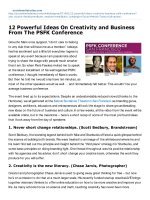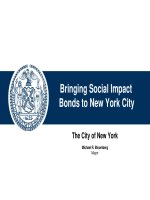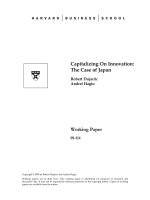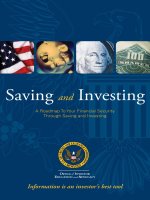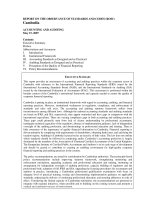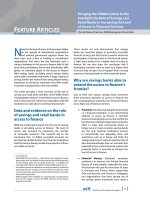Capitalizing on career chaos bringing creativity and purpose to your work and life HELEN HARKNESS
Bạn đang xem bản rút gọn của tài liệu. Xem và tải ngay bản đầy đủ của tài liệu tại đây (984.33 KB, 185 trang )
CAPITALIZING ON
Career
Chaos
Bringing Creativity and Purpose
to Your Work and Life
HELEN HARKNESS
PRAISE FOR capitalizing on career chaos
“Harkness is the epitome of the difference between knowledge and
wisdom. She is able to distill volumes of information into useful,
practical advice. I am delighted that she has made the effort to share
this wisdom through her books.”
Irvin C. Shambaugh, president,
Aptitude Inventory Measurement Service (AIMS)
“Helen Harkness saved my life! After a twenty-plus-year career
ended, I found myself ‘wandering aimlessly’ trying—unsuccessfully—
to find my niche. I could never have succeeded had Helen not come
into my life and helped me pave the right path.”
Ed Bamberger, CEO, The Single Gourmet of Dallas-Forth Worth, Inc.
“This book eloquently and in very practical terms shows us how to
embrace chaos as a tool of change. Let Helen Harkness deliver you
from angst and confusion and guide you to a new, more positive perspective that offers both reality and hope. A wonderful book.”
Rex McGee, screenwriter and member of
the Writers Guild of America and Dramatists Guild
“Capitalizing on Career Chaos is a perceptive guide for making sense of
the changes affecting work and careers. The author’s wit, insight,
and practical advice make it a certain winner. A must-read for individuals seeking to manage their careers and for career counselors
and coaches.”
Keith O. Nave, president, Career Management
Partners/Lincolnshire International
“Harkness has led many of us to new directions in our careers. In
this book she expands on the concepts she has taught for years and
updates them for today’s fast-changing environment. A must-read
for everyone facing career or personal challenges.”
Buddy Frazer, owner, MPF Services; chairman,
Dallas County Historical Commission
“Helen Harkness is a legend in career counseling. Whether you’re a
disgruntled lawyer, unhappy executive, unsatisfied academic, or
frustrated technologist, she can help you change your career and
your life—for the better.”
Bill Lee, president, Lee Communications;
author, Mavericks in the Workplace
“The author’s approach to writing, like her approach in dealing with
her clients, is practical and available to put to immediate use. An
invaluable tool in making the most of a change of career scenery.”
Ross W. Vick III, general partner, What Is Mine LP
“Helen Harkness brings experience, focus, and practicality to the
career counseling process. I was grateful for her guidance as I made
a major career adjustment, and twenty-five years later I still recommend her to others.”
Eileen Hall, partner, Hall & Green LLP
“A wise and wonderful guide through the world of career chaos.
Whether you are a midlife career changer like me or someone who is
looking for a sane, reassuring voice in the mass of career advice, this
book can move you from fear to new career.”
Nancy Wiese, osteopathic physician
“Helen Harkness’s approach to career planning in this era of relentless change has rescued many of us from the dark abyss of an
unhappy, misguided work life. Her message about embracing change
is important not only to individuals considering career shifts, but
also to business leaders who understand the value of people who are
passionate about their work and fearless in the face of chaos.”
Scott Spreier, leadership coach and consultant
Capitalizing on
Career
Chaos
Bringing Creativity and Purpose
to Your Work and Life
HELEN HARKNESS
Davies-Black Publishing
Mountain View, California
Published by Davies-Black Publishing, a division of CPP, Inc., 1055 Joaquin
Road, Suite 200, Mountain View, CA 94043; 800-624-1765.
Special discounts on bulk quantities of Davies-Black books are available to corporations, professional associations, and other organizations. For details, contact the
Director of Marketing and Sales at Davies-Black Publishing; 650-691-9123; fax
650-623-9271.
Copyright © 2005 by Davies-Black Publishing, a division of CPP, Inc. All rights
reserved. No part of this book may be reproduced, stored in a retrieval system,
or transmitted in any form or by any means, electronic, mechanical, photocopying, recording, or otherwise, without written permission of the publisher,
except in the case of brief quotations embodied in critical articles or reviews.
Cover illustration: Michael Rowley/Stockart.com
Visit the Davies-Black Publishing Web site at www.daviesblack.com.
09 08 07 06 05 10 9 8 7 6 5 4 3 2 1
Printed in the United States of America
Library of Congress Cataloging-in-Publication Data
Harkness, Helen
Capitalizing on career chaos : bringing creativity and purpose to your work
and life / Helen Harkness.— 1st ed.
p. cm.
Includes bibliographical references and index.
ISBN 0-89106-209-2 (pbk.)
1. Career changes. 2. Career development. 3. Creative ability. 4. Crisis management. 5. Quality of work life. I. Title.
HF5384.H3695 2005
650.1—dc22
2005004529
FIRST EDITION
First printing 2005
CONTENTS
List of Activities vii
Preface ix
Acknowledgments xv
About the Author xvii
Introduction xix
1
Understanding Chaos for Career Planning 1
P A R T I : Living and Working on the Edge of Chaos
2
Finding Our Contemporary Career Patterns 19
3
Searching for the Authentic Self 25
4
Experiencing the Dark Night of Change 43
P A R T I I : Redesigning Our Careers
5
Looking Inward 61
6
Looking Outward 75
7
Looking Forward 91
8
Taking Action 111
9
Looking Beyond 133
Epilogue 143
Resources 151
References 153
Index 157
V
59
17
ACTIVITIES
1
Finding Clues to Your Meaning Magnets 64
2
Positive Accomplishments of Your Life 66
3
Your Success Criteria 69
4
Asking the Grail Questions 79
5
Envisioning the Future 97
6
Creative Attributes 104
7
Creativity and Innovation Checklist 108
8
Summarizing Your Career Design Plan So Far 112
9
Self-Defeating Self-Talk 118
10
Identifying Your Self-Defeating Behaviors 119
11
Resisting Change Questionnaire 121
12
Decision-Making Outline 123
13
Acting on Your Goals 126
14
Free Agent/Entrepreneur Characteristics Indicator 128
VII
PREFACE
No problem can be solved from the same
level of consciousness that created it.
—ALBERT EINSTEIN
Careers are the lens through which I view the world. Enhancing
careers in chaos and in conflict with former dreams and expectations
has been the focus of my work for three decades. I am a teacher and
strategist and when it comes to capitalizing, not capsizing, on career
chaos, I have been there personally and professionally. Crisis and disorder ultimately brought purpose and creativity to my life and work.
I frequently take a moment to thank my maker for the chaos in
my early forties that forced me to refocus my career direction, to
move positively forward through the very real pain of change in my
life and work, and to gain the meaning and purpose for pursuing my
personal power. I later realized that in changing my career I was
ahead of my time—that in the future it would become a more normal course of events for adults. How on target I was!
Since my doctoral study focusing on careers and the incorporation of my company, Career Design Associates, in 1978, I have
relentlessly studied past, current, and future forces affecting and
transforming the workplace: the economy, the business world, the
educational system, technology, society, and the individual. I have
coupled this active research base and my extensive experience with
adults and their careers with the intuition and foresight gained from
my life/work experiences.
It is paradoxical that what provided me with insight and direction in the midst of confusion and chaos thirty years ago came not
IX
X
C A P I TA L I Z I N G O N C A R E E R C H A O S
from my humanities education but from a totally random contact
with the newly emerging science of chaos and complexity. It’s almost
as if I became overloaded and an entirely different approach was
necessary. Understand, however, that this book is career focused and
not a scientific treatment of the theories of chaos and complexity
(though I can provide a bibliography and probably own most of the
publications of the major contributors to the field of quantum
physics). It is an exploration—a search for what we nonscientists can
learn from this developing science. My purpose is to communicate
what I have learned from my research and my personal and professional experience—with its checkerboard of successes and failures—
that might provide insight, guidance, and direction to adults seeking to take creative control of their careers in this uncertain age.
Discovering that chaos breeds creativity (by breaking apart the
known and familiar) was what I have since labeled a personal power
point, keeping me moving forward at a time when all carefully laid
plans had turned to mush!
I remember well my introduction to Alvin Toffler and future
thinking in 1970. I was sincerely, if rather ineptly, trying to keep
bored freshmen awake in a Monday-Wednesday-Friday 1 p.m.
English class. Giving up on Shakespeare and the glories of the
Elizabethan Age and striving to be relevant (the rallying cry of the
seventies), I dashed out and almost instinctively—since I had read
only a short review—bought a stack of Toffler’s Future Shock. The
book was selling briskly (sales would eventually top 7 million
copies—an unbelievable number since it didn’t revolve around
Hollywood, sex, quick-fix motivation, or a get-rich-quick formula).
And it gave us a new term, “future shock,” which entered our vocabulary and frankly now describes much of our current life.
I can’t say how the book affected my students, but it triggered a
powerful, life-changing “Aha!” of critical insight for me. This was the
beginning of my focus on change and the future—the writing,
research, speaking, and teaching; the establishment of Career
Design Associates, Inc.; my active career consulting at the World
Preface
Future Society conferences for two decades; and publication of three
books: Best Jobs for the Future, The Career Chase, and Don’t Stop the
Career Clock.
In the early 1970s, Toffler’s prediction of three to five career
changes seemed ludicrous until I thought more deeply. Up to that
point hard work and a college degree had been touted as the magic
keys—all that one really needed for career success. Couple this with
the reality that in the early 1970s only one in nine Ph.D.s found a
teaching position in academia; vast numbers were driving taxis and
teaching part-time in junior colleges with a salary that, when all the
extra time was added up, amounted to minimum wage. Gypsy scholars were in and tenure was out!
As a physician’s wife in the 1960s, I had read that if a woman
got a Ph.D., she could possibly become president of a university. Ten
years later, I had to face the realization that as a single parent, I could
not rear three children on the salary I earned as a teacher/administrator at a small liberal arts college that was on the verge of closing.
I also could not expect to teach at a first-rate university because of
the fifteen years I had taken off to spend with my children. I recognized that with a Ph.D. and a dime, I could get a cup of coffee. After
some thought, brought to the surface by Toffler’s forecast, I knew
that a career change was my destiny.
Toffler’s definition of future shock described my life at that time:
total disorientation, shattering stress, and overwhelming unexpected
change, parachuting me into a chaotic world where reality clashed
with my former expectations and rules. Identifying that I was indeed
in future shock released me from the negative search to attempt to
identify the mistakes and failures I assumed I had made to create all
these problems for myself.
It was amazing how this insight changed my perspective, set me
on a positive course, and settled me on my purpose in life. My quest
became the search for understanding and focus in my life by studying careers, the change process, and the future. For thirty years my
purpose, pursued with passion and persistence, has been to translate
XI
XII
C A P I TA L I Z I N G O N C A R E E R C H A O S
my insight into effective strategies to teach adults how to gain creative control of their careers in this chaotic, confusing, and changing work world.
The future, as forecast, has arrived. Changing, recharging, refocusing, renewing, recareering, and multicareering are only now
being seen as a necessity for career success and not the indulgent,
irresponsible actions of an immature, indecisive person! This, combined with the mass of change from all directions, shows that we are
indeed experiencing Toffler’s future shock.
So, where are we today? And what’s next? We are immersed in
an important cultural transition—continual change and uncertainty are our reality. From necessity or desire we must embrace a
new way to define and handle our careers.
Though a nonscientist, I have gained much from chaos and complexity theory. Primarily, I have learned that chaos and complexity
are not simply negative confusion breaking up our world. They are
the mechanisms through which change is initiated and organized,
the first steps by which the world creates diversity, rebirth, and
renewal. Chaos is everywhere: Mastering chaos for our career success requires new ways of seeing, thinking, and acting. This is what
I teach my clients in career transition and what I would like you, the
reader, to realize and use.
Instead of being orderly, stable, and in equilibrium, as expected
from our past, our reality is seething and bubbling with change, disorder, and process. However, our system of thinking has forced order
over it—made it fit and ignored all information that didn’t seem to
belong. Disorder has been treated as negative noise to be avoided at
all costs. However, all systems have subsystems that are continually
fluctuating, and at times a combination of these will become so powerful that they reach a bifurcation point, a branching or forking, that
shatters our preexisting organization. This can be a huge catastrophe or merely a fringe event. It is impossible to predict which direction change will take—whether the system will become chaotic,
Preface
from which a higher order spontaneously arises through a process of
self-organization, or be a barely noticeable ripple.
We individuals—human beings—are self-organizing systems
capable of creating a higher order out of chaos in a chaotic world,
and we can no longer wait for the majority, our authorities and institutions, to lead the way as they did in the past. The great physicist
Erwin Schrödinger said that it takes at least fifty years—half a century!—for a major scientific discovery to penetrate the public consciousness. We cannot afford this! The cost is too great to our
ecological systems, career relationships, health, culture, and collective future. We are duty-bound to search, question, and open our
minds. Pioneering is becoming an increasingly psychospiritual venture, since our physical frontiers are all but exhausted.
I’ve found that institutions—schools, government, and churches—
rather than providing leadership and direction in helping us deal
with future shock and unrelenting change, frequently trail at least a
decade behind. For the most part they are doing what they have
always done, and often in the same old way. As a result, many established systems no longer meet our critical needs. Yet we continue to
count on them with apparently little awareness of the gap between
what is being provided and the reality of our needs.
It is clear to me now that all the uncertainty, chaos, and triggering events I experienced forced me to cultivate and release my creativity, resilience, commitment, and indeed the cornerstones of my
resourcefulness and strength. I have written this book to bring order
to my thinking about chaos and careers, since order and chaos exist
side by side. I must understand and assimilate the knowledge if
I am to move to the next step in my growth and development. For my
career clients, I must integrate and communicate my insight and
information on these very deep changes that carry danger and
opportunity. Where I have been on this subject for years feels to
me like the essential warm-up time of an orchestra, all instruments sounding on their own, tuning up individually but together
XIII
XIV
C A P I TA L I Z I N G O N C A R E E R C H A O S
unmelodious and discordant, with no recognizable tune. Before I
move forward in my work, I want to write the score, hear it played,
and pass it on to others. As a teacher, I am dedicated to passing on
career-related insights. Bringing coherence to my thought process
relating careers and theories of chaos and complexity is critical for
me to move forward and make my next leap of learning.
ACKNOWLEDGMENTS
A special appreciation
To my clients, from whom I learn much and who trust me to be
committed to do whatever is effective, legal, and ethical to help them
achieve their purpose—and I expect them to do the same for themselves and others! To my former clients, who have graciously and
thoughtfully shared their career insights and information with current clients. To my professional colleagues, from whom I gain much
insight, and whose well-being and good fortune I value. And to Dr.
John Holland, whose research and tools have been especially meaningful in my career work with adults.
To my grandchildren, Laura, Lucas, Leslie, Bonnie, and Milo, and
my daughters, Jane and Ann. When I expressed the concern that my
grandchildren, because of my schedule and geographic location,
would not remember me as a cookie-making grandmother, one
spoke up: “Not a cookie maker but a money maker! Calories are
out—a car and college beats cookies anytime!” This may be the
emerging paradigm for contemporary grandmothers.
To my sister, Madolyn Stewart, who has traveled with a limited
budget and made friends on five continents, and who, though
chronologically older, serves as a role model for me and my clients on
how to stay young in spirit—and deserves credit for carrying much
of my personal load, as well as hundreds of books to and from our
library.
To the Reverend Willie Cobbs, whose weekday role is caring for
my greenhouse plants and our newly developing Oak Tree Farm. He
is patient with my passion for plant growth because, as he explains
it, “It’s in your heart and you can’t help it!”
XV
XVI
C A P I TA L I Z I N G O N C A R E E R C H A O S
A very special thanks to Robert Kraakevik, reference librarian at
the South Garland Branch of the Nicholson Memorial Library. Since
the staff is a library’s most important asset, Bob—who changed from
a career as a teacher/businessman at midlife—has demonstrated
how valuable one in his position and with his commitment can be to
the community.
To Shelley Fleming; without her (and Scotch tape, scissors, and
erasers), this book would not have become a tangible reality. Shelley
successfully and patiently read my notes, corrected, suggested,
edited, and researched online. I am deeply grateful for the order she
can magically create from my manuscript notes.
And finally to Lee Langhammer Law, Laura Simonds, and
Connie Kallback at Davies-Black for their professionalism, responsiveness, attention, encouragement, energy, and patience!
ABOUT THE AUTHOR
Helen Harkness, Ph.D., is a pioneer in career management who
founded Career Design Associates, Inc. (CDA), in the Dallas–Ft.
Worth area in 1978. Her work through CDA reflects and integrates
her multidimensional career as a successful entrepreneur in business
and investments; an experienced educator and administrator (former academic dean/provost, college professor, and director of continuing education); and a director of human resources and human
services in city government.
A superb strategist and resourceful catalyst, as well as an experienced teacher, futurist, consultant, researcher, and speaker,
Harkness spurs others to act while providing resources and realistic
direction for the process of change. Harkness’s CDA credo and battle
cry in today’s uncertainty is: “Freedom is knowing your options.”
With her CDA clients, she founded the Pathfinders for the Future
Think Tank, which meets monthly to explore, research, and forecast
current trends and future possibilities as they relate to the workplace. This has created 400 videos and DVDs on specific careers for
client use. Harkness has also written and produced a series of educational videotapes, Careers in Finance and Discovering Career Options,
featuring John Holland, author of the Self-Directed Search assessment; and, through CDA, has created the Internet Career Design
Assessment Profile™, a career assessment process for individuals in
the workplace. Harkness teaches classes on careers through
Southern Methodist University and The S’Cool, a privately owned
continuing education company.
Regularly quoted in newspapers and magazines across the country, Harkness is author of Best Jobs for the Future (1996), The Career
XVII
XVIII
C A P I TA L I Z I N G O N C A R E E R C H A O S
Chase (1997), and Don’t Stop the Career Clock (1999). In 2003, she
received the first Professional of the Year Award from the Association of Career Professionals (ACP International), Dallas–Ft. Worth
Chapter. The award permanently carries her name as the Helen
Harkness Professional of the Year Award.
Helen Harkness, Ph.D.
Career Design Associates, Inc.
2818 South Country Club Road
Garland, Texas 75043
phone: (972) 278-4701 fax: (972) 278-7092
www.career-design.com
INTRODUCTION
The work world is up for reinvention in so many ways. Creativity is
born in the reinvention . . . . We can’t wait for great visions from
great people, for they are in short supply at the end of history.
It is up to us to light our small fires in the darkness.
—CHARLES HANDY
In this era of rapid change and uncertainty, our conventional, traditional career planning for success is archaic—as outdated as the
slide rule or the typewriter. The customary paths to career success—
the linear corporate (go to college, get a job, move up the ladder and
stay for forty years, retire to die!) and the steady-state path of the
professional specialist (the doctor, lawyer, teacher, or engineer)—are
absolutely over. Today the average career will likely include two or
three occupations and multiple employers. Millions will spend time
in self-employment, and 12 to 27 million will be in microbusinesses
with four or fewer employees (Peters 2003, p. 239). The spiral career
path with significant changes about every seven to ten years—nontraditional and somewhat frowned upon in the past—is rapidly
becoming the necessary new norm.
The necessity to unlearn our former career concepts and to
change and redirect our careers, perhaps multiple times, is a growing reality. Though predicted by futurists for more than three
decades, this reality is only now reaching center stage for most
Americans. The new model is unbelievably difficult for adults reared,
perhaps unconsciously, to expect and revere a predictable, linear
journey based on stability and certainty, consisting of twelve to
XIX
XX
C A P I TA L I Z I N G O N C A R E E R C H A O S
twenty years of schooling, followed by a forty-year career path, and
then, typically, total retirement.
It would be foolish to predict the exact shape of careers in the
future or to suggest a quick fix to the current career crisis facing
many adults as career expectations collide with reality. What is
needed instead is an awareness that the current crises create both
danger and opportunity for career growth and development, and an
understanding of how that awareness can be used to capitalize creatively on the chaos of change. The purpose of this book is to provide
career-related information, insight, strategies, connections, and
encouragement for adults to gain their personal power, freedom from
fear of change, and an understanding of their options.
Working successfully now and in the future demands that we
assume direct responsibility and control over our individual careers.
This will require insight, creativity, and an action plan based on a different perception—a new way of seeing and experiencing the reality
of our evolving, changing culture, ourselves, and the working
environment.
The critical issue is how we as individuals can live and work in
our age of constant change and chaos, making a successful transition from the Industrial Age to the age of technology and innovation, and still achieve the personal and career goals that we value.
Resolving this issue involves creating a shift in our identity and
establishing a new conceptual framework.
Because in this country we are tied so closely to the work we do,
some very real changes in our self-concept, our definition of who we
are, need to be made. For many, this can be frightening and even paralyzing. To be a truly functioning person we must have a sense of
identity—a sense of our place in the environment. This is wholeness—uniting that which we perceive ourselves to be and that which
we perceive others to see and to expect of us.
We are currently experiencing problems in work identity
because the reinforcement messages received from our workplace
and society, and perhaps from our own selves, are scrambled and
Introduction
fragmented instead of being strong and supportive. For this reason,
it is critical that we have the confidence, courage, and competence to
think for ourselves: to reexamine our expectations, attitudes, behaviors, decision-making processes, and perceptions of career/self reality, as well as to become aware of the external changing realities in
our environment. How congruent are all our former, accepted rules
with what is really happening in our work world in this first decade
of the twenty-first century? Are we really on track to achieve what
has meaning for our work lives, or are we sidetracked on a fast track
to nowhere? Are we, like Alice, speaking to the Cheshire Cat?
“Would you tell me, please, which way I ought to walk from
here?”
“That depends a good deal on where you want to get to,” said
the Cat.
“I don’t much care where,” said Alice.
“Then it doesn’t matter which way you walk,” said the Cat.
(Carroll 1946, p. 62)
We must know where we want to go. We can’t wait for the world,
our traditional institutions, our culture, our social and educational
systems, to catch up with us and our career problems and map out
exactly how to solve them. We must solve these ourselves, but not by
ourselves. To succeed we must connect, communicate, and collaborate with others. We must take the calculated—but educated and
informed—risk of jumping into our best future.
We also need to develop a distinctively new conceptual framework of thinking about our career problems and issues that will give
us a sense of continuity between our past, present, and future experiences. This is the essential foundation for developing clear, harmonious life/work goals and a plan for achieving them. Trying to solve
problems in the same old way is like continuing to look for a lost
object in the same drawer. The following preview of the chapters in
this book will give you a sense of how we’ll approach the broad topic
of capitalizing on career chaos.
XXI
XXII
C A P I TA L I Z I N G O N C A R E E R C H A O S
Chapter 1, Understanding Chaos for Career Planning, focuses on
the big picture—the deeper environmental shifts and thinking about
how our contemporary world works. Beginning in the 1970s, chaos
and complexity theories, which demonstrate the capacity of living
systems to respond to disorder (nonequilibrium) with renewed life,
have become cultural metaphors. Our reality is rapidly moving from
simplicity, stability, and certainty to complexity, instability, and
unpredictability. Our current decade is experiencing extreme chaos
created by this transition. It is critical that we individuals who are
being thrust out on the cutting edge of change recognize that chaos
creates the birth of new opportunities.
Part I, Living and Working on the Edge of Chaos, discusses a new
career pattern that is rapidly evolving, replacing our revered vertical
forty-year-certainty career ladder (Chapter 2); the search for the
authentic self (Chapter 3); and the experience referred to as “the
dark night of change” (Chapter 4).
Part II, Redesigning Our Careers, provides details of the career
design process. These include looking inward through a variety of
self-assessment processes to gain authentic awareness (Chapter 5);
looking outward for information about the challenge, needs, and
opportunities in the external world (Chapter 6); looking forward—
coordinating the internal and the external into a coherent future
vision (Chapter 7); and taking action to reach our goals (Chapter 8).
In Chapter 9, we will take a brief look beyond the individual to chaos
and change in organizations.
ONE
Understanding Chaos
for Career Planning
All the tumult and seeming chaos, when viewed in the light
of historical perspective, can be seen to represent not only the
death agonies of an older order but also the birth pangs of
a new epoch—a new golden age which assuredly will
outshine those of the past.
— L . S . S TAV R I A N O S , H I S T O R I A N
Over the past few decades, chaos theory has been used widely in the
natural sciences. More recently, it has begun to be applied to the
social sciences as well. Understanding the key characteristics of
chaos theory (and the related theory on complexity) leads to a shift
in how we view change and an understanding of our ability to influence and use change creatively.
The Advent of Chaos
Edward Lorenz was a research meteorologist and mathematician
working at the Massachusetts Institute of Technology in the
early 1960s. His job was coming up with accurate forecasts and
weather models to help meteorologists, and it was beginning
to seem futile. His weather models forecast the same weather
1
2
C A P I TA L I Z I N G O N C A R E E R C H A O S
day after day, yet the weather outside changed constantly. On
this particular day, Lorenz as usual started the next run of data
on his now-antique computer and trekked down to the coffeepot to avoid the noise. When he returned to his desk, he found
that instead of spitting out the expected and usual patterns,
the weather pattern predictions were fluctuating wildly.
Lorenz was really puzzled; his intuition told him that something significant was happening. But as he retraced his actions
just before leaving the room, he found that nothing was different. He’d done everything just as he’d done it a hundred times
before. Then he remembered: He had abbreviated one of the
numbers he was using to represent atmospheric conditions.
Instead of entering 0.506127, he had rounded the number to
0.506 and, after entering it, left the program to run. What he
discovered on his return—that a very small difference (less
than one part in one thousand) in the initial conditions led to
large changes in the weather predicted by his model over
time—developed into what we know today as chaos theory and
revolutionized the way we think about change.
We are moving into an age that will require an active imagination
and an ability to change dramatically—not abilities we have traditionally cultivated. There are no separate, isolated problems anymore. We are all tied together in a system, and when we move one
part, all are affected. If we want to gain any real insight into our personal and career problems, we must connect those problems with
the broader changes and shifts in our world.
The step-by-step planning of the career models of the past is
obsolete. Career planning today acknowledges and even embraces
the messiness of social, economic, demographic, and political phenomena and their often unexpected events. It requires insight into
how and when to change and when to adapt or discard old patterns
while retaining essential elements to incorporate into new patterns.

